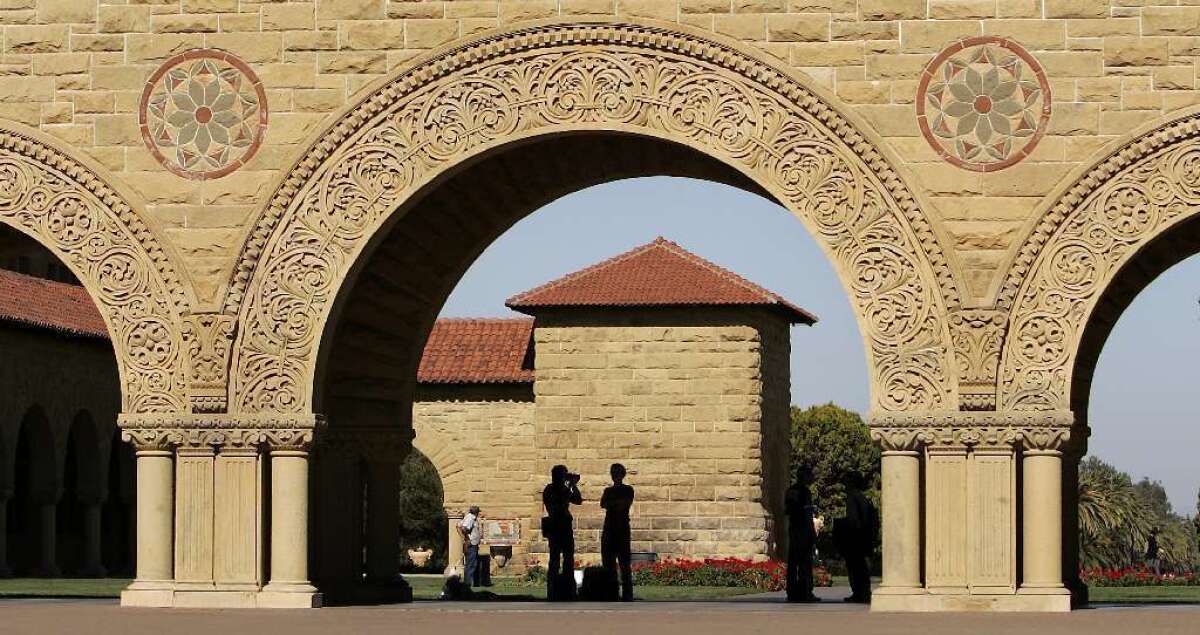Stanford bans hard alcohol from undergraduate parties, citing ‘dangers that arise’ from binge drinking

Hard alcohol will be prohibited at all on-campus undergraduate parties, university officials announced this week.
- Share via
Months after a high-profile sexual assault case, Stanford University has banned hard alcohol from undergraduate parties and shots from graduate-student parties.
University officials said this week’s move was designed to limit the availability of distilled liquor as well as the violence, vandalism and other consequences that may come from binge drinking.
“The University does not tolerate reckless drinking — lawful or unlawful — and its consequent harmful behaviors,” according to the updated student alcohol policy. “The University is especially concerned about the misuse of distilled alcohol products (“hard alcohol”), and the dangers that arise from that misuse.”
Brock Turner, a former Stanford University swimmer who in June was sentenced to six months in jail for sexually assaulting an unconscious woman behind a dumpster on campus, blamed “party culture and risk-taking behavior” for his actions.
Describing himself as an “inexperienced drinker and party-goer,” Turner, in a letter he penned to Santa Clara County Superior Court Judge Aaron Persky, said he had never experienced partying that involved alcohol until he attended Stanford, where he began drinking to relieve the stress of school and competitive swimming.
See the most-read stories this hour >>
“The swim team set no limits on partying or drinking and I saw the guys take full advantage of these circumstances, while I was shown to do the same,” he wrote.
On Jan. 17, 2015, the night of the sexual assault, Turner said he drank five beers and two “swigs” of Fireball whiskey and bounced from one party to another.
Documents released later by the Santa Clara County Superior Court showed that Turner was not new to drinking before college, and depicted a party culture in which Turner had made aggressive, unwanted advances on women.
Earlier this year, university officials met with students, faculty and staff to discuss ways to address drinking culture on campus and the pressure that students may feel to drink.
“High-risk drinking is not a problem unique to Stanford, but we believe that the strategies we pursue to address the negative consequences of this behavior must be rooted in our particular campus culture and our respect for one another,” Greg Boardman, vice provost for student affairs, wrote in an email Monday to students.
“Among the concerns we hear are that some students drink alcohol as a means to overcome social anxiety and others feel alienated by their peers’ drinking, sometimes to the extent that they do not feel welcome in their own houses or organizations,” he wrote. “These dynamics are unacceptable to us, as are the range of problems that are too frequently associated with alcohol misuse.”
The swim team set no limits on partying or drinking and I saw the guys take full advantage of these circumstances, while I was shown to do the same.
— Brock Turner in a letter to Judge Aaron Persky
The university’s updated alcohol policy still allows beer and wine at on-campus undergraduate parties, but specifically limits hard alcohol. Hard liquor — defined as more than 40 proof, or 20% alcohol by volume — must be in bottles smaller than 750 milliliters in undergraduate dorm rooms and common spaces or when consumed by undergraduates at any public space on campus, such as athletic facilities or dining halls.
“Any group or residence that includes undergraduate members is subject to this policy restriction,” the policy states. “Groups and residences that are 100 percent graduate student in membership are exempt and may have hard alcohol in the form of mixed drinks at registered ‘Members’ parties.’”
Straight shots of hard alcohol, the policy notes, are prohibited at all parties.
Bottles smaller than 750 milliliters are allowed for students 21 and older, but the alcohol must be contained and stored in the original bottle in which it was purchased from a licensed establishment, the university said.
Since most retailers only sell bottles of hard alcohol larger than 750 ml, the policy could reduce the availability of hard alcohol at parties. The restrictions do not amount to a total ban, but focus on limiting high-risk, binge-drinking behavior, said Ralph Castro, director of the university’s office of alcohol policy and education.
Depending on the circumstances, students who violate the alcohol policy could be sent to mandatory alcohol education seminars or referred to counseling or treatment. Continued or concerning behavior may result in removal from university housing or other disciplinary measures, Castro said.
The ban likely will be unpopular when students return to campus in September. In a campus-wide referendum this spring, more than 91% voted against a hard alcohol ban, and about 1,720 people signed a petition against the proposal, according to the Stanford Daily.
Boardman, in his letter to students, acknowledged that some of them may try to find a way around the rules.
“I challenge you not to focus on the policy as something to be worked around. Instead, I ask you to bring your best selves to this endeavor, to consider the real concerns raised by your fellow students, and those articulated here, and to be a part of solving this problem,” he wrote. “We must create a campus community that allows for alcohol to be a part of the social lives of some of our students, but not to define the social and communal lives of all of our students.”
Follow @RosannaXia for more education news
ALSO
In a major win for teachers unions, California Supreme Court lets teacher tenure ruling stand
More than 400 new USC students are the first college-goers in their families
UPDATES:
4:30 p.m.: This article was updated with additional editing.
This article was originally published at 11:20 a.m.
More to Read
Sign up for Essential California
The most important California stories and recommendations in your inbox every morning.
You may occasionally receive promotional content from the Los Angeles Times.














